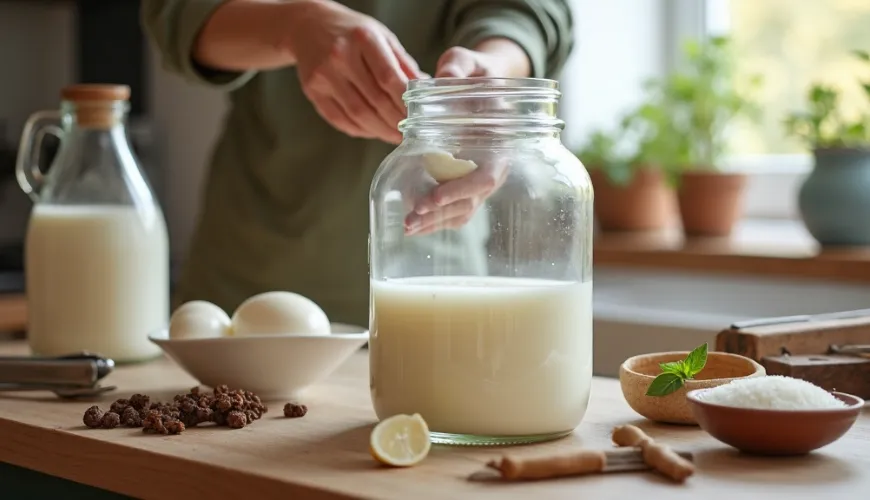
Discover the magic of kyška, a healthy drink from the Czech countryside

Valašská Kyška - The Forgotten Treasure of Our Ancestors Returns to the Modern Kitchen
Among traditional Czech foods, there are those that have firmly held their place on tables for centuries, yet seem to have gotten a bit lost in the wave of industrially processed products in modern times. One such item is kyška, or "thinner sour milk," as many remember from childhood in the countryside. This unassuming drink, however, hides surprising power—both for health and taste buds.
What is Kyška and Why is it Being Talked About Again?
Kyška is sour milk produced by fermentation using naturally occurring lactic bacteria. In the past, it was a common part of the diet in the Czech and especially Valašsko countryside, where it was known as "Valašská kyška." Traditionally, it was made by letting fresh milk sour naturally, often overnight or over several days at room temperature, without being pasteurized or artificially inoculated with cultures.
Today, kyška is typically produced in a controlled manner in dairies—yet true, authentic Valašská kyška remains a specialty that many people prepare at home according to old recipes. This is what brings it back into the spotlight—at a time when interest in local, natural, and fermented foods is growing, kyška is being rediscovered as a tasty and healthy addition to the diet.
Kyška vs. Kefir – What’s the Difference?
At first glance, kyška might resemble kefir—both drinks are fermented, have a milk base, and contain beneficial bacteria. However, there are fundamental differences between them. Kefir is produced by fermenting milk using so-called kefir grains, which is a specific combination of bacteria and yeasts. As a result, kefir is slightly fizzy, sometimes even sparkling, and its taste is often sharper.
In contrast, kyška is milder, thinner, and does not contain yeast. Its composition is dominated solely by lactic bacteria, primarily species from the Lactobacillus and Streptococcus genera. This gives kyška a smoother taste and it does not contain alcohol, which can appear in small amounts in kefir.
Another difference is in the method of preparation. While kefir requires regular care of the kefir grains, kyška is simpler to prepare—all you need is quality milk and a bit of starter culture, such as a spoonful of already-made kyška or sour cream.
Health Benefits of Kyška - Why Include This Drink in Your Diet?
At a time when interest in healthy gut flora is rising, kyška plays a significant role. It contains natural probiotic cultures that support digestion, immunity, and overall vitality. Fermented products generally help break down lactose, so people with mild lactose intolerance can often tolerate kyška without problems.
Regular consumption of kyška can bring the following benefits:
- Improved digestion thanks to the presence of live cultures.
- Support for immunity – the gut microbiome plays a key role in defense against infections.
- Supply of B vitamins, which are produced during fermentation.
- Low caloric value – ideal for a reduction diet or a light breakfast.
- Better absorption of calcium and other minerals, which are naturally present in milk.
Interestingly, according to traditional Chinese medicine and Ayurveda, fermented foods have the ability to harmonize digestion and calm the body after consuming heavy meals. And kyška, served perhaps with boiled potatoes or bread, was a common part of lunch or dinner in the Valašsko countryside for generations.
Valašská Kyška as Part of Tradition and Modern Cuisine
Valašsko, a region known for its rich folk culture and strong connection to nature, has always been home to simple yet nutritious meals. Kyška was used not only as a drink but also as a base for sauces, soups, or leavened doughs.
In some Valašsko households, kyška is still prepared today just as it was once: fresh milk is left to stand at room temperature in a glass container, covered with a cloth, and in two to three days, a gently sour, creamy drink is formed. In summer, it was drunk chilled; in winter, it was used for cooking.
Perhaps someone remembers a grandmother who, after working in the fields, brought a plate of boiled potatoes, which she poured over with cold kyška—a simple meal, but with exceptional taste. "That was a meal that kept you going all day," say the old-timers from Valašsko.
Even today, kyška can be used in various ways in modern cuisine. Thanks to its mild flavor, it fits into smoothies, dressings, as a substitute for yogurt with muesli, or as a light replacement for cream in soups. Combined with fresh herbs like chives, dill, or parsley, it creates a refreshing dip that children will love.
Where Did It Disappear from the Shelves and How to Make It at Home?
Although the demand for local and fermented foods is growing, kyška remains more of a rarity. It is found only occasionally in regular supermarkets, often labeled as "sour milk" or "acidophilus milk." Original Valašská kyška, made in the traditional way, appears at farmers' markets and in the offerings of small dairies that are reviving old recipes.
Homemade production is not complicated—take 1 liter of fresh whole milk (ideally farm-fresh, unpasteurized), mix in 1 to 2 tablespoons of finished kyška or sour cream as a starter, and pour everything into a glass container. Cover with a towel or loosely placed lid and let it stand at room temperature for about one to two days. Once the mixture thickens and becomes slightly sour, put it in the fridge—it can last there for a week.
This simple process not only brings a tasty result but also the joy of returning to a natural way of eating.
Kyška Today: A Return to Roots and a Step Forward
At a time when more and more people are trying to avoid added sugars, preservatives, and overly processed foods, Valašská kyška represents a return to simplicity. It is a product that contains nothing extra—just milk and live bacteria. And that is its greatest strength.
At the same time, it is an incredibly versatile ingredient. Simple to make, easy to digest, and full of nutrition. Whether you drink it as a refreshing beverage, use it in cooking or baking, or prepare it at home as a small experiment to support your microbiome, kyška has a lot to offer.
It may not return to widespread consumption on a large scale—but those who try it often return to it. And that's the magic of traditional foods: they're not only healthy but also connected with stories, traditions, and memories that give food an entirely new dimension.

